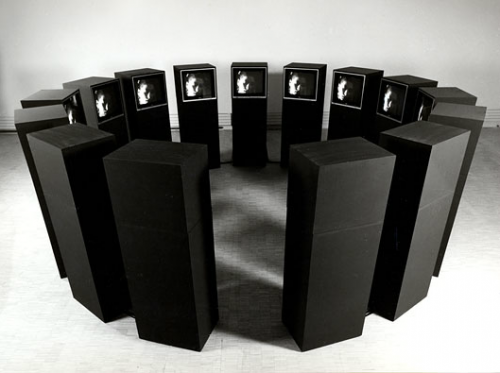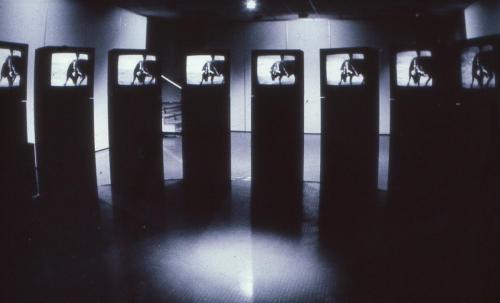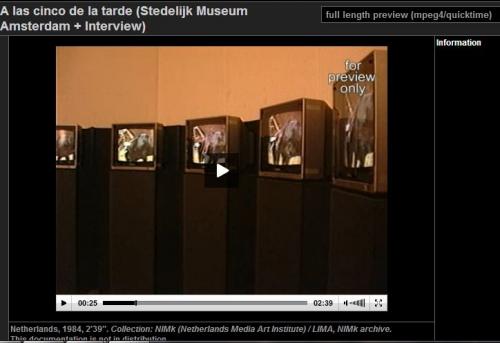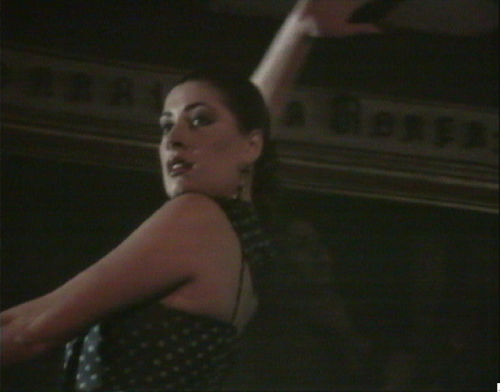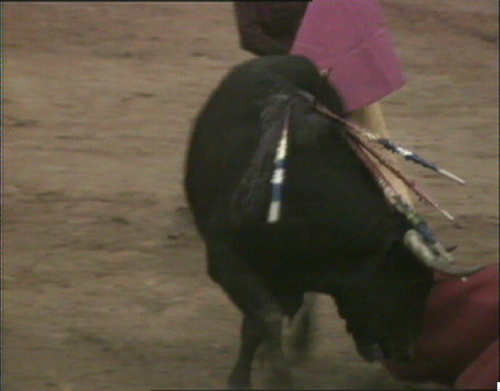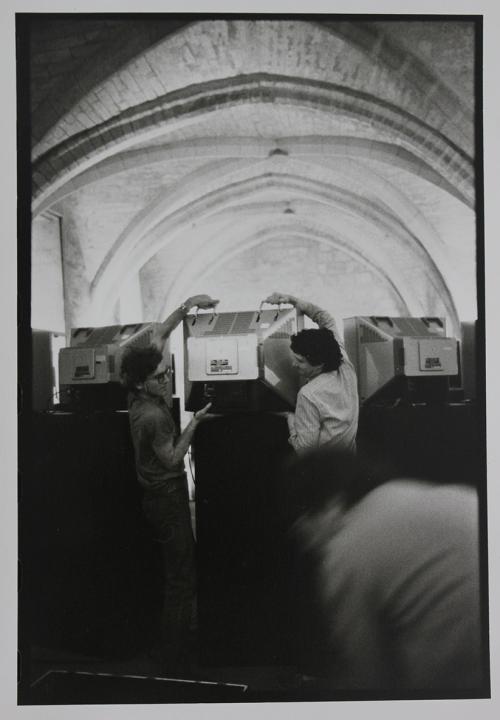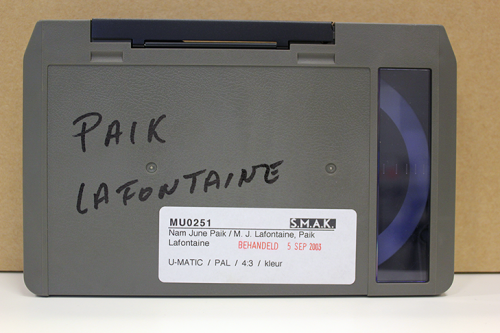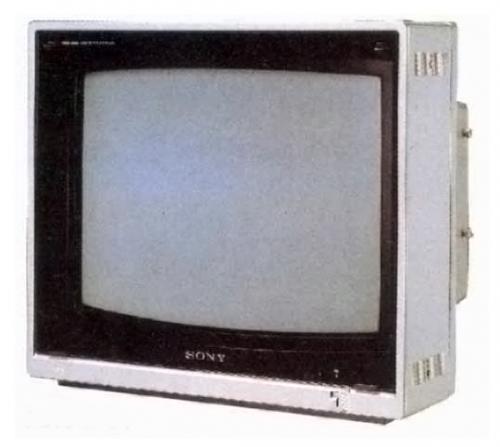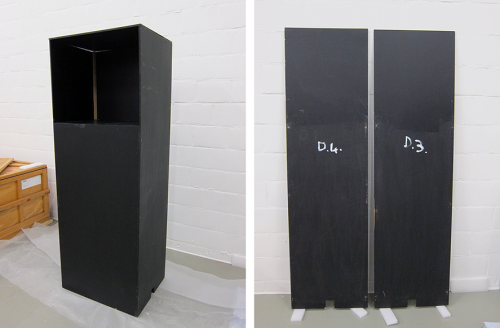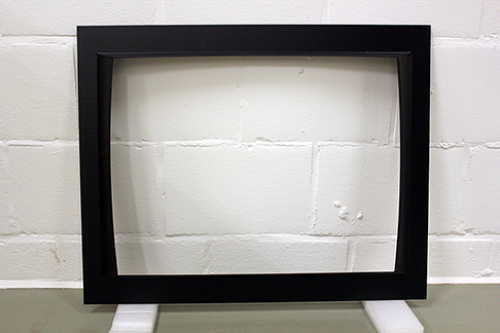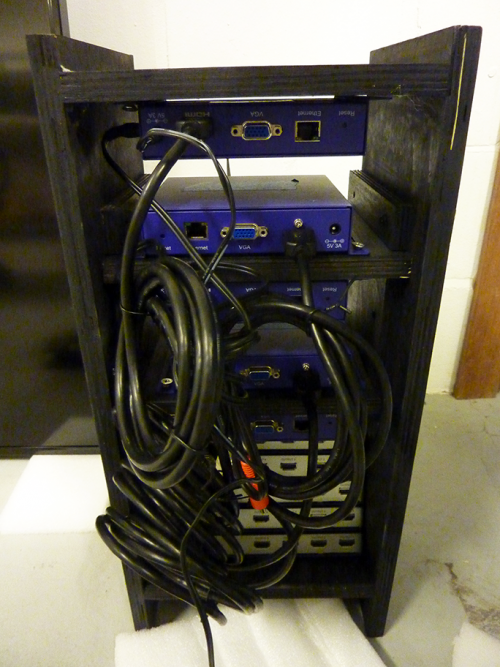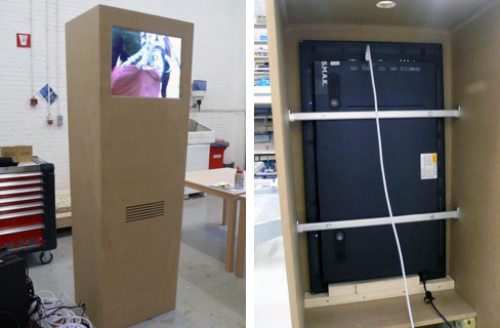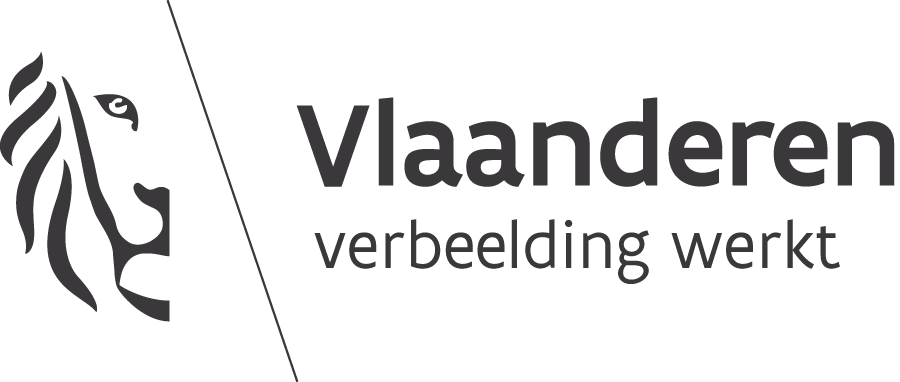Case study report: A las cinco de la tarde (1984, Marie-Jo Lafontaine)
Artist: Marie-Jo Lafontaine
Title: A las cinco de la tarde
Date of creation: 1984
Type: Video installation
Collection: S.M.A.K.
Researcher: Annika Räim (University of Amsterdam, Preservation and Presentation of the Moving Image), Veronique Despodt (S.M.A.K.), Emanuel Lorrain (PACKED vzw)
Language of the case study report: English
1 Description
1.1 Short biography of the artist1
Marie-Jo Lafontaine is a Belgian artist who was born in 1950 in Antwerp, Belgium. From 1975 to 1979 she studied at the École Nationale Supérieure d’Architecture et des Arts Visuels, La Cambre in Brussels. She spent the year of 1985 at MIT in Boston.
In the 1980s she began to work on environments with video sculpture, amongst the first of these was Round Around the Ring (1981). In 1987 she took part in the Documenta 8 exhibition, where her video-sculpture Les Larmes d’Acier marked the artist’s international breakthrough. Marie-Jo Lafontaine is also well-known for the integration of art in public spaces, such as the Stockholm airport or the Justice Palace in Bonn. She was appointed Cultural Ambassador of Flanders in 1998 and, in 2006, she won the arena-project I Love the World during the opening of the World Soccer Championships in Frankfurt am Main. Various forms of visual expression, such as monochrome painting, writing, sculpture, photography and video are combined in her œuvre. Her works have been shown in exhibitions in leading international galleries and museums and are represented in the collections of ZKM, Mu.ZEE, S.M.A.K., etc.
1.2 Short description of the artwork
A las cinco de la tarde can be described as a space that provides a visual and sound experience. It consists of fifteen screens on black wooden pedestals of ca. 2 m high. The screens are at eye level. The pedestals form a circle that the viewer is expected to enter. The video depicts flamenco dancers performing and bullfighters confronting a bull. The same video is displayed on every screen but the screens are divided into five groups and each group displays the video with a certain time delay. Adjacent screens show moments of the video that are a few frames different. The video moves somewhat like a wave on the fifteen screens. Special effects such as slow motion and reversed playback were used in the video. The sound of the artwork is not directly connected to the images shown in the video. The playback equipment is not visible in the installation.
A las cinco de la tarde has been displayed in multiple manifestations with variations in its appearance. The artist sees A las cinco de la tarde as a work in process2, in terms of the design of the pedestals, the size of the monitors, the dimensions of the installation, the location of the circle entrance which changed during the course of various displays. (See sections 4 and 5 for further details.)
1.3 Meaning of the artwork
At the time she was creating the artwork, the artist was an avid admirer of flamenco and she had a close connection with some of the tablaos flamenco in Madrid. The video content was filmed during the festivities of San Isidro in Madrid. At that time Marie-Jo Lafontaine was also reading books by Federico Garcia Lorca and Ernest Hemingway who both wrote about corrida. The title of the artwork A las cinco de la tarde is taken from the poem La cogida y la muerte by Federico Garcia Lorca.2
Similar to most of Marie-Jo Lafontaine’s early video works, A las cinco de la tarde is about violence, illusion, death. In this piece the images of the bullfight merge with the shots from flamenco dancing just as desire, seduction and the urge for power are under-linked3. The artist states that in the video “the flamenco dancer and the matador are just the same, they give only illusions”4.
A las cinco de la tarde is a multiscreen video installation which consist of several video tapes and monitors, in which, alongside the spatial effect of the individual images, relations are created between the rhythm and direction of the movement. According to the artist the moving image can be read horizontally, because it goes around all of the monitors. The artist stated in an interview that the viewer can also "look at it vertically and you just look at one image, but you are surrounded by the other ones and the sound is around you"2.
The visual and sonorous appearance of the work has a high importance for the meaning of the work. The arrangement of the monitors is like the enclosure of an arena or a dance floor with the spectator in the middle. The expressiveness of the artwork lies in the situation created by the sound, the moving image and the specific arrangement of the monitors. There is no direct sound (i.e. stamping feet of flamenco dancers). Various types of music have been used for the soundtrack: instrumental flamenco music and classical vocal music.
Special effects such as slow motion and reversed playback are used to create a certain rhythm and dramaturgy for the images. As Marie-Jo Lafontaine stated, slow motion is "like when you take an elastic band and open [stretch] it, you see more than when it's [unstretched] like this. Of course it provides a different dramaturgy when you slow mote the image a little bit."2
2. Documentation/registration
2.1. Archives and literature
2.1.1. Archives
S.M.A.K. archives
- Individual folder Lafontaine, Marie Jo: decisions, correspondence and other documents
- Photo library
Marie-Jo Lafontaine: photo library
2.1.2. Literature
- The Luminous Image. Amsterdam: Stedelijk Museum, 1984.
- Marie-Jo Lafontaine. Lyon: Saint Pierre Art Contemporain, 1984.
- Performance art and video installation. London: Tate Gallery, 1985.
- Marie-Jo Lafontaine : Sculpture vidéo/son "A las cinco de la tarde" & sculptures récentes. Villeneuve d'Ascq: Musée d'Art Moderne, 1985.
- Beelden in de koepel II : Barbara Bloom, H. J. Brethouwer, Sonja Oudendijk, Marie-Jo Lafontaine, Sonja Visser, Piet Dirckx. Arnhem: Gemeentemuseum Arnhem, 1987.
- Patteeuw, Roland and Jan Foncé. Marie-Jo Lafontaine : Videosculpturen = Sculptures-video = Video sculptures. Zedlegem: Stichting Kunst en Projecten, 1987.
- McLeod, Fiona, ed. Marie-Jo Lafontaine. Edinburgh: Fruitmarket Gallery; London: Whitechapel Art Gallery, 1989.
- Marie-Jo Lafontaine: Passio. Salzburg: Salzburger Küntslerhaus Kunstverein, 1990.
- Bussmann, Georg. Le principe de séduction, 1990. See: Le principe de séduction (Accessed 17.09.2013)
- Picasso. A Contemporary Dialogue. Salzburg/Paris: Galerie Thaddaeus Ropac,1996.
- Barde, Bernd, ed. Marie-Jo Lafontaine. Ostfildern-Ruit: Hatje Cantz Verlag, 1999.
- Marie-Jo Lafontaine. Liquid Crystals. Darmstad: Hatje Cantz Verlag, 1999.
- Smallenburg, Sandra. Schoonheid. See: 2.2. Artist interviews
- Artist interview with Marie-Jo Lafontaine and documentation of the artwork (The Luminous Image exhibition, Stedelijk Museum, Amsterdam, 1984)
- Video interview with Marie-Jo Lafontaine by NIMK.nl (Accessed 17.10.2013); and can be viewed on YouTube.
- Artist interview with Marie-Jo Lafontaine by Veronique Despodt, Emanuel Lorrain and Annika Räim. Brussels, 20.09.2013.
2.4. Video registration(s) of the artwork
- Installation view and interview with the artist filmed at the exhibition The Luminous Image at the Stedelijk Museum, Amsterdam 1984 (viewed at NIMK.nl , accessed 29.10.2013) and can be viewed on YouTube.
- “De Langste Dag” by Jef Cornelis (Belgische Radio en Televisie, BRT) (viewed at S.M.A.K.)
2.5 Exhibition history of the artwork
In the case of all the exhibitions listed below the artwork was presented on behalf of the artist. After the acquisition of A las cinco de la tarde in 1986 S.M.A.K. received several loan requests to exhibit the artwork in and outside of the museum premises. These requests were not fulfilled for questions of budget.
1984
• The Luminous Image, Stedelijk Museum, Amsterdam (premiere)
• Centre National d’Art et de Culture Georges Pompidou, Paris
• Galerie Powerhouse, Montréal
• Circulo de Bellas Artes, Madrid
• Video 84, Contemporary Art Museum, Montréal
• Maison de La Culture, La Rochelle
• Octobre des Arts, L’E.L.A.C. Lyon1985
• Europalia Espagna, Cultureel Centrum, Hasselt
• Sculpture vidéo-son, Musée d’Art Moderne, Villeneuve d’Ascq
• Joseph Illsert Gallery, Boston
• The Tate Gallery, London
• Maison de la Culture, La Rochelle
• Vidéographie Cirque d’hiver, Liège (TV)
• Maison de la Culture, Le Havre
• FIAC, Gallerie Roger Pailhas, Paris
• Unknown location, Saint-Etienne1986
• Initiatief ’86, Sint-Pietersabdij, Ghent
• Carpenter Center of the Visual Arts, Harvard University, Boston
• Galleria d’arte Moderna, Bologna
• Salle Pétrarque, Montpellier
• Les gardiens du Jeu, Musée Cantini, Marseille
• Sprengel museum, Hannover
• Art Jonction International, Nice1987
• Koninklijk muziekconservatorium, Ghent
1996
• Im Dialogue mit Picasso, Galerie Ropac, Salzburg
3 Making of the artwork
3.1 Audiovisual material
Description of the audiovisual material
Video
The video content of the work was filmed over one week at the festivities of San Isidro in Madrid. The artist formed a crew for this purpose. After shooting the images, Marie-Jo Lafontaine pre-edited the footage in her studio with two U-matic players. The final editing took place in the broadcasting studio of the Radio Télévision Belge (RTB). The artist paid special attention to the editing phase. She notes: "I think for me the editing is the most important part of it. To film it, of course you have to be at the right place and have the right camera, but the content, you do it when you edit it on the machines. Then you get the atmosphere you are looking for. That takes most of the time for me."
The video content was originally recorded on U-matic. First the images of flamenco dancers appear, followed by images from the corrida where a bull is confronted by matadors.
Duration of the video: ca. 8’ 51’’
So far the video has been shown with the title "marie jo lafontaine - a las cinco de la tarde - 1984" in the beginning of each U-matic tape with the length of ca. 54 minutes. It means that the title appeared once every 54 minutes. When the video is to be digitised with titles in the beginning and played back as a digital file, the artist considers the titles to be unnecessary, since the titles would appear too often (every 8 minutes and 51 seconds) and might tire the viewer. The wall label with necessary information is sufficient5.
The U-matic tape in the possession of S.M.A.K. contains titles at the beginning and credits in the end.
Duration of the video with titles and credits: 10’ 05’’
Audio
The video uses no direct sound, the audio was added during the editing of the video. The soundtrack of the work is made of musical excerpts from her LP collection.
3.2 Used equipment (video recording)
There is not much information about the equipment used for the recording of the video. The artist remembered that the video was filmed on U-matic. The pre-editing was made with two U-matic players and the final editing was completed in a professional broadcasting studio of the RTBF.
3.3 Installation / construction
The construction of the artwork consists of fifteen wooden pedestals painted in black. Monitors are installed inside each pedestal at the approximate eye level of the viewer and are covered from the sides and on top. The playback equipment (players, synchronization unit and speakers) are located inside the pedestals and are not visible.
The first time A las cinco de la tarde was shown at The Luminous Image exhibition in 1984, the construction was somewhat different from its later manifestations. On this occasion the monitors were not installed inside the pedestals, but were placed on top of the pedestals, leaving the monitors entirely visible. Also, a dark cloth was used to dim the light in the space. The artist was not satisfied with this presentation of the work and the construction was later re-designed.
The design and measurements of the pedestals are dependent on the display equipment used. Pedestals need to be in accordance with the measurements of the monitors and the construction has been re-designed by the artist's collaborator Martial Thomas on the occasions when there have been changes in the display equipment. The artist emphasizes that the construction needs to be built carefully, i.e. the screws of the pedestals should not be visible and the painted surface should not show the signs of wear.
According to the artist the artwork is to be seen as a work in progress, that may undergo changes in terms of display equipment, and therefore also of the design of the construction.
4 Technique
4.1 Video
Original format
U-matic tapes were used during the production and editing of the work, and also to exhibit the work. S.M.A.K. likely acquired five presentation copies on U-matic from the Initiatief '86 exhibition and no master tape was handed over to the museum. These presentation tapes are no longer present in the museum. The museum only possesses the audiovisual content of A las cinco de la tarde on one U-matic tape as part of a compilation of several works.
The artist was contacted in order to determine whether any artist’s master could be used for achieving the best results when creating a digital master. No master was found and the artist provided fifteen U-matic exhibition copies from different periods of time. Additionally, three U-matic tapes with the audiovisual content of A las cinco de la tarde were found in the Argos' archives in Brussels.
All the above-mentioned U-matic tapes were assessed in order to determine the one holding the best quality version for further preservation actions. (see section 6.1.1 and 6.2)
4.2 Original playback and display equipment
A las cinco de la tarde was originally shown using five U-matic players and fifteen CRT monitors (the specific model of the monitors varied from one exhibition to the other).
The synchronization system was built by an engineer from the Centre Pompidou in Paris using a custom made device. When installed, the cables of the equipment were hidden as much as possible and the wires were covered with a black cable duct or tape on the floor.
4.3 Overview of selected exhibitions and propositions
In the table below the technical specifications from the selected exhibitions and propositions are presented. The propositions indicate the occasions on which the artwork was requested for a loan and for this purpose its technical requirements were specified. The request was nevertheless rejected for questions of budget.
The information is based on the documentation found from the S.M.A.K. archives, literature and/or based on the recollections of Marie-Jo Lafontaine and her collaborators.
Exhibition/comments Playback and display The Luminous Image
1984
Stedelijk Museum, AmsterdamComments: the work premiered during this exhibition. The monitors were not inside the pedestals, but visible from every side. Since the space was too light, dark cloth was used to dim the light in the space surrounded by the pedestals. The artist was not satisfied with this setting: the monitors were too small and the solution with the dark cloth was not suitable for the artist.
- 15 monitors: SONY KX-20PS1
- U-matic players
- No information about the other equipment.
Octobre des Arts,
1984
L’E.L.A.C. Lyon- 15 monitors
- U-matic video players
- U-matic tapes
- A time delay in the form of an electronic box made by an engineer from the Centre Pompidou, Paris.
- 4 distributors of the electric signal: SONY DA 500
The plan for the distribution of the time delay was given by Marie-Jo Lafontaine.
Initiatief ’86
1986
Sint-Pietersabdij, Ghent- 15 monitors: SONY KX-27PS1
- No information about the other equipment.
General specification by the artist after 19876
Comments: The specifications were probably sent prior to the exhibition Im Dialogue mit Picasso, at Galerie Ropac, Salzburg, 1996.
- 15 monitors: SONY PVM 2730
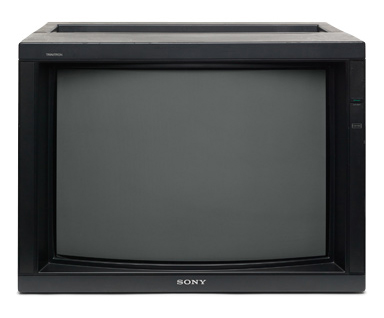
- 5 U-matic players: SONY 7040
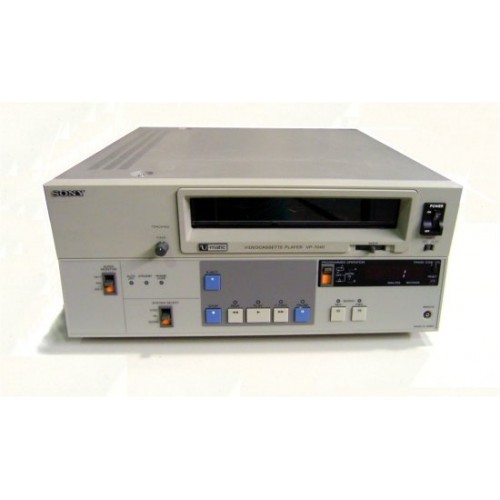
- 4 distributors: SONY DA 500
- 1 amplifier: SONY TAF 700ES
- 4 audio monitors: SONY MV-S7
- 5 video carriers: U-matic cassettes Sony 60 BRC
- 1 computer
Femmes et Tauromachies (Loan request)
2003
Musée des Cultures taurines, Nimes
Comments: the work was not shown during the exhibition. The technical specification was a proposition.
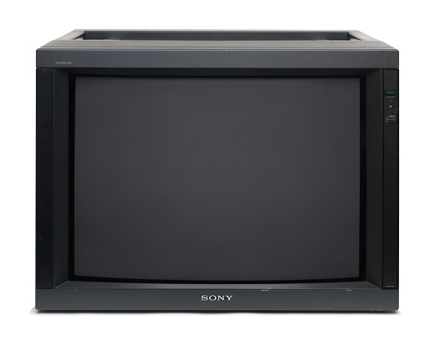
- 15 monitors: SONY 2950 QM.
- An alternative option: Hantarex CT 28.
- 5 DVD players: Philips DVD pro-175
- 5 distributors: DA 1-6
- 1 amplifyer: SONY TA-FE 330
- 6 audio monitors
- 1 bassmodul: Canton C plus
- 5 video carriers: DVD R7
Present equipment
The display and playback equipment used for the Initiatief ’86 exhibition, after which the artwork was acquired by the S.M.A.K. collection, is not available at S.M.A.K. as it was never acquired by the museum. However, in the course of the years S.M.A.K. acquired 15 Hantarex CT 28 monitors to show the work.
5. Installation instructions
5.1 Former installation instructions
In Marie-Jo Lafontaine’s artist portfolio (probably from 1985) the concept of the ideal conditions for A las cinco de la tarde is provided. According to these instructions the artwork should ideally be installed in a square space of ca. 750 x 700 cm. The entrance of the space would lead directly to the centre of the circle of pedestals. The floorplan from the Initiatief '86 exhibition at Sint-Pietersabdij in 1986 indicates that a viewer was expected to enter the circle of pedestals from the side that was easily accessible.
5.2 Present installation instructions
During her artist’s interview, Marie-Jo Lafontaine emphasized that in the course of various exhibitions she began to prefer not having the entrance of the circle on the same line as the entrance of the space. The entrance to the circle of pedestals should not be located in the immediate proximity of the entrance of the space.
There are additional requirements that the artist brought up during her interview which need to be considered while installing the artwork:- Instead of provding the ideal measurements for the space Marie-Jo Lafontaine emphasizes that the approximate diameter of the circle of pedestals needs to be 350-380 cm. The exact diameter of the circle depends on the size of the monitors. Also the size of the pedestals depends on the display equipment.
- 10-15 people can go into the circle at the same time.
- The installation can be placed in the same space as other artworks, as long as the sound of the other artworks is not disturbing the viewers.
- The middle point of the monitor should be approximately at 170 cm from the ground.
- The cables of the equipment should run on the ground and should be covered with a black, made-to-measure, cable duct.
- Three or four speakers for the sound should be placed inside the pedestals. The sound is mono and comes from channel group n°3.
- The light level depends on the quality of the monitors.
- The width of the image should not be less than 50 cm.
The artist has stated that the titles and credits part of the version present on the compilation tape should not be shown in the installation as it would appear too often and tire the viewer. In the past, when the work was shown from the U-matic tapes, the titles and credits appeared just once every 54 minutes.
6. Conservation
6.1 Conservation history
During the case study it became clear that only the video and the pedestals which were paid for by the Vereniging voor het Museum van Hedendaagse Kunst were acquired in 1986 by S.M.A.K. collection. Since the work has not been shown by the museum since then, no conservation actions were taken after the acquisition. On the occasion of a loan request in 2003 the museum received updated documentation on the equipment and construction by the artist.
6.1.1 Audiovisual material
When this case study began S.M.A.K. had no master or presentation copies of the audiovisual content of A las cinco de la tarde. S.M.A.K. had a copy of the video on a U-matic tape. This tape didn't have the status of an artwork in the collection but more of an archival or documentation value. The content of the U-matic tape itself is a compilation with various video works by Nam June Paik and Marie-Jo Lafontaine. There is no documentation about the purposes for which the compilation was created. Meanwhile, the tape has been kept in controlled storage conditions at S.M.A.K8.
Marie-Jo Lafontaine had already had the video part of the artwork digitised once in the past and according to her, the outcome wasn't satisfying, since it was made quickly with not enough attention paid to the image quality (drop outs, brightness, contrast and colour levels, etc.). She said, during the interview, that different copies were compared and different sources were used to create one digital version.
6.1.2 Playback equipment
S.M.A.K. did not acquire any equipment from the Initiatief’86 exhibition. The 2003 documentation created by Martial Thomas led to the acquisition of 15 Hantarex CT 28 monitors. However, these monitors were never dedicated to the work and are also being used to exhibit other artworks in the museum.
6.1.3 Parts installation
The parts of the pedestals used for the Initiatief '86 exhibition are to be found in S.M.A.K. collection:
30 back and front panels 136.2 x 68.2 x 3.5 cm
30 side panels 192 x 55 x 1 cm
15 back panels 57.2 x 68.2x 3.7 cm
15 top shelves 55 x 70 x 1 cm
15 inner shelves (opening for the cables)51.5 x 68 x1 cmThe back, front and side panels have white letters from A to O, and numbers from 1-4 on the inner sides. During the course of this case study, the parts of pedestal D were superficially dry cleaned. Front sides of the pedestal with the Japanese brush, back sides with vacuum cleaner brush.
6.2 Conservation plan
As mentioned, A las cinco de la tarde is not complete in the S.M.A.K. collection. Therefore, the missing elements had to be retrieved in close collaboration with the artist. While doing so, the issues about the long-term preservation of the artwork and detailed guidelines for the installation were also discussed. In order to achieve completeness and integrity of A las cinco de la tarde, four elements had to be retrieved or recreated:
- The audiovisual content
- The display equipment
- The playback and synchronization of the video
- The pedestals
1) The audiovisual content
So far the audiovisual content of A las cinco de la tarde had been preserved and played back from its original format- U-matic tapes. Since the analog U-matic technology in general is obsolete, it was necessary to migrate the audiovisual content of the artwork to a digital format. For digitisation purposes the tape with the best quality was selected. As no master tape was found either in the museum collection or from the artist's archive, all the exhibition tapes identified during the case study were compared and assessed. This comparison work was carried out using well-maintained U-matic players and a professional CRT monitor.
The U-matic tapes that were assessed:
- 1 compilation tape from S.M.A.K. (MU0251)
- 15 presentation copies from different generations from the artist's archives
- 3 tapes from the Argos archives in Brussels
After the assessment, one tape from the artist's archive was selected for the digitisation. The U-matic tape was digitised without any digital correction by AV Works in Haarlem, Netherlands.
Digital master file specifications Container AVI Video codec v210 Image compression Uncompressed Video bit-depth 10 bit Chroma sub-sampling YUV 4:2:2 Image size 720 x 576 pixels Aspect ratio 4:3 Audio codec PCM Audio bit-depth 16 bit Audio channels Mono The artist has expressed her will to assess the digitised video for possible colour corrections. The digital master file will be preserved without digital correction by S.M.A.K. in multiple copies and kept in separate locations. After the digitisation the U-matic tapes should be preserved under controlled climate conditions. In the case in which the digital files get corrupted or lost, the tapes will have to be digitised again.
2) Display equipment
The display equipment has a twofold role in the aspect of the artwork. Firstly, since the work was originally created for CRT monitors and these have also been used so far for the exhibition purposes, the display equipment has offered specific qualities and associations with the time in which the artwork was originally created. Secondly, the use of CRT monitors determined the sculptural form of the artwork, since their cubical shape and the 4:3 aspect ratio were taken as a basis for designing the pedestals and the circle. The choice of new display equipment can have an impact on the overall look of the artwork.
In the course of various exhibitions the display equipment has varied in terms of its size and manufacturer. The smallest size of the monitor used for the presentation has been 20", the largest size has been 28". In previous versions of the work CRT monitors have always been used. During the case study several options were considered for replacing the display equipment:
a) Acquiring further CRT monitors.
S.M.A.K. has 15 CRT monitors (Hantarex CT 28) that can be used for exhibiting the artwork. For prolonging the functioning of the artwork additional monitors of the same type would have to be acquired. This option would maintain the technical historicity and context of the artwork. It requires the least modification in the design of the construction. By the time these monitors stop functioning there may be new technology available to display the work similarly to the way it was originally created (i.e. keeping the original aspect ratio).
Since cathode ray tube technology is no longer manufactured, these monitors and their spare parts are already very difficult to find. Due to high demand, the price of such monitors has risen considerably on the second hand market. This option would be to postpone the obsolescence problem for a certain period of time, but sooner or later the CRT monitors will stop functioning and the issue of updating the display equipment will rise again.
b) Replacing the CRT monitors with current flat screen monitors.
In the artist interview Marie-Jo Lafontaine states that she considers the 4:3 aspect ratio to be an important feature of the artwork. The prevalent aspect ratio for flatscreen monitors is 16:9. At the start of the case study the flatscreen 4:3 aspect ratio were not available in sizes bigger than 21". In order to retain the original aspect ratio of the screen (i.e. 4:3) an open frame flatscreen with appropriate aspect ratio9 was considered as an option. However, due to the small size of this monitor (i.e. 20,1" gives approximately 40 cm of active screen area), it was not considered suitable.
In order to maintain the aspect ratio of the artwork and the desired size of the image (i.e. min 50 cm of width) a 42" LCD screen will be used in portrait mode. The video image in 4:3 aspect ratio will be tilted and lifted on the upper part of the screen. The pedestal will cover the lower part of the screen.
After testing an Hantarex 42" Lite LED monitor in portrait mode and consulting with Marie-Jo Lafontaine, it was chosen for future presentations of A las cinco de la tarde. Since the screens are standing in a circle, the qualities of the display equipment should allow one to view the image from the side without considerable distortions. For this purpose, special attention was paid to the criteria of brightness, contrast ratio and viewing angle of the screen10. Settings of the monitors such as, amongst others, contrast, colours and brightness, were set together with the artist.
Despite the fact that the original aspect ratio of 4:3 can be retained by using 16:9 screens in portrait mode and the sculptural form of the installation is not changed, it is necessary to consider how to provide information to the visitor about the change in display equipment.Additionally to the fifteen monitors, two spare monitors of the same model were bought in case one of the active ones fail. The twenty exemplars will be dedicated to the presentation of A las cinco de la tarde and won't be used for any other purpose in the museum.
3) Playback and synchronization of the video
The video of A las cinco de la tarde is played back in accordance with a predefined temporal sequence. The monitors of the video sculpture are divided into five groups (A, B, C, D, E), each group playing the video with a certain delay compared to the previous group. The monitors of each group are then placed side by side in this order:
B-A-B-C-D-E-D-C-B-A-B-C-D-E-D
The original playback and synchronization system of A las cinco de la tarde consisted of five U-matic players and a custom-made synchronizer using beep tones recorded on each tape to sync-up all the U-matic players and play the five tapes with the desired delay. The original playback equipment didn't have any sculptural value as it wasn't visible in the original version of the installation. Thus, the behaviour of the original set-up could be recreated with current technologies without modifying the look or meaning of the work. PACKED vzw and S.M.A.K. asked for three different new playback and synchronization systems and the Johan Schelfhout one from Maverick ICS in Belgium was selected for the work.
The new playback system of A Las Cinco de la Tarde is based on five solid state players (BrightSign HD1020) with programming and networking capabilities.
- One player act as a 'master' controlling the remaining four 'slave' media players using the GPIO input and output of the media players.
- A H.264 version of the digital video was created from the digital master and loaded into each one of the BrightSign media players using SD flash memory card.
- Each BrightSign player sends the video signal to a 4-port HDMI splitter (ATEN VS184) from where the signal is then sent to the monitors belonging to the same group.
- HDMI 1.3b professional grade cables are used in order to feed the fifteen monitors with the video signal.
The critical aspect was to recreate the same time interval between the different channels as in the original version of the work. No documentation about the synchronization was found in the museum. As such, the new synchronization was based on three different sources:
- Using fifteen U-matic tapes from the artist's archive used in different set-ups of the installation in the 1980s, we noted the timecode where beep tones appeared. By comparing these timecodes it should be possible to calculate the time interval between each tape.
- Video footage of the installation running when exhibited at The Luminous Image show at the Stedelijk Museum in Amsterdam.
- Feedback from the artist on the synchronization of the new version.
Because of the bad shape of some of the U-matic tapes and because of some uncertainty as to whether the five tapes were really used in the same presentation of the work, basing the new synchronization on the beep tones seemed imprecise. Basing it on footage from the first exhibition of the work appeared much more efficient as the new synchronization could be compared to the original one in real time by Maverick ICS. The artist then validated the amount of delay between each group of channels.
Technically, the delay between each group of channels was specified and programmed using BrightSign's authoring software BrightAuthor. The five groups are synchronized via network using UDP protocol and the five 4-port HDMI splitters are used to order the video signals according to the specified group configuration diagram previously mentionned (BABCDEDCBABCDED).
The experience of Johan Schelfhout with this set-up of BrightSign players in previous projects produced by Maverick ICS is that it is very reliable in operation. This configuration ensures that, within each group (ie. group A) the signal is absolutely synchronized. While there can be a drift of one or two frames between two different groups (ie. between group A and B) this potential drift that may (but not always) occur is more than acceptable since there is a delay of several seconds between the groups.
In collaboration with the artist the synchronization will be thoroughly documented. An accurate and precise documentation of the synchronization is crucial to recreate the work in the future without the functional equipment and the artist's presence.
The new set-up only needs to be plugged to the mains in order to start and display the fifteen videos in the expected way. This makes turning on and off the installation a very easy procedure for the staff at S.M.A.K. or at any other venue where the work will be shown. The BrightSign players, the splitters and their power supplies are all hidden in one of the pedestals. Cables running from one pedestal to the other are covered and completely invisible. The audio soundtrack of the work is sent to two amplified speakers and a subwoofer placed in the central pedestal using the analogue BNC output of one BrightSign player.
4) The pedestals
The pedestals from the Initiatief '86 exhibition still retained by S.M.A.K. were not suitable for the new flat screen Hantarex monitors. New pedestals were designed by Marie-Jo Lafontaine's collaborator Martial Thomas and built by the S.M.A.K. production team. The look of the original fifteen pedestals was used as a reference in this process and as in previous manifestations of the work, the pedestals are painted in black.
The new pedestals allow the fifteen flat screen Hantarex monitors to be placed and fixed in portrait mode in order to hide the lower portion of the screen behind the wooden front panel. The opening on the front panel has a 4:3 aspect ratio to allow only the part of the screen where the video is displayed to be visible. The media players, the splitter and the speakers are placed in one of the pedestals. Specific attention was put on creating enough ventilation openings to dissipate the heat produced by the monitors and the other electronic equipment.
6.3 Current components of the work in 2015
- 15 monitors: Hantarex LITE 42 (+ 2 spares)
- 5 BrightSign HD1020 media players (+ 1 spare)
- 5 ATEN VS184 4-port HDMI splitters
- 1.3b HDMi cables
Conclusion
A las cinco de la tarde only remained in the S.M.A.K. collection in the form of disassembled pedestals, a U-matic screening copy and lacunar installation instructions. The impossibility for S.M.A.K. to fulfill loan requests for the work was the trigger for this case study. With the preservation and update of its components and of its documentation, the video installation has now taken on a sort of second life in the museum. The important part of this restoration process has been the creation of a useful documentation and description of the functioning of the work (timing, aspect of the video, size of the space, disposition, etc.) and of the critical aspects of its look and meaning on which further versions could be based. For indeed, obsolescence and wear will force the museum to carry out migration to new formats and replacement of the works' technical components in the future. To postpone this moment as long as possible, proper handling and storage conditions of the new display and playback equipment are crucial.
A large portion of the research for this case study was done by Annika Raïm during her joint internship in 2014 at S.M.A.K. and PACKED vzw, in collaboration with Veronique Despodt and Emanuel Lorrain.
Notes:
- 1. See: Picasso. A Contemporary Dialogue. Salzburg/Paris: Galerie Thaddaeus Ropac, 1996, 151-152; Samuelis Baumgarte Galerie,artist's Biography: Marie-Jo Lafontaine, accessed 28.09.2013.
- 2. a. b. c. d. Artist interview
- 3. Delphine Renard, Marie-Jo Lafontaine: an eternal story, in Lyon, 1984, 21-25.
- 4. Video interview with Marie-Jo Lafontaine, on NIMK.nl, accessed 29.11.2013; and can be viewed on YouTube.
- 5. Telephone conversation of Annika Räim with Marie-Jo Lafontaine, 30.10.2013
- 6. Specifications by Marie-Jo Lafontaine, document in S.M.A.K. archives.
- 7. Specifications by Martial Thomas.
- 8. The tape was cleaned in 2003, as indicated by a white paper (a RTI one) present on the cassette. It was the time when audiovisual artworks in S.M.A.K. collection were digitised to Digital Betacam. Likely because the compilation tape with the video of A las cinco de la tarde did not have the status of an artwork, it got cleaned, but not digitised.
- 9. Hantarex LCD 20,1" OLB201
- 10. Hantarex 42 Lite LED screen has brightness of 450 cd/m2, contrast ratio 4000:1 and viewing angle of 178 degrees.

